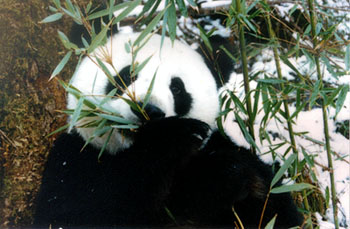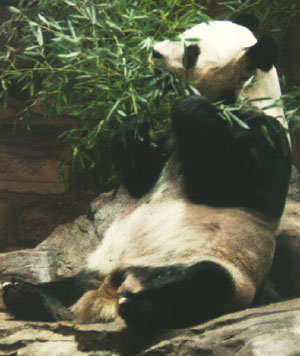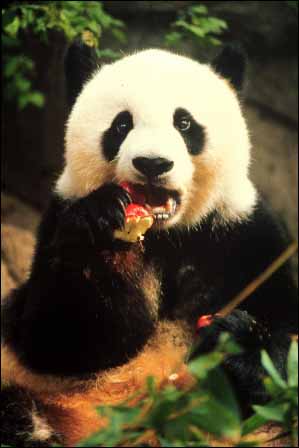������The wild giant panda is omnivorous though more than ninety-nine percent of what it eats is bamboo. Occasionally, it will eat other types of plants including weeds, herbs, vines, shrubs, trees and grasses. It will also eat meat, including that of bamboo rats, golden monkeys, musk deer, and sheep. However, pandas rarely catch prey because of their slowness and seldom scavenge because large predators are rare in panda country and leave few remains behind after feeding. Pandas in captivity are given a wider variety of food by their keepers. Their meals often include rice, meat, eggs, milk, fruit, carrots, potatoes, honey, bread, chocolate, vitamin and mineral supplements, as well as bamboo.
������Because giant pandas are unable to efficiently digest bamboo and thus absorb only a small percentage of the nutrients in it, they must consume vast amounts of it in order to ensure that they get enough nutrients. A wild panda spends about 12 to 16 hours a day feeding and may eat up to 40 lb of bamboo daily, sometimes even more. Panda droppings contain much undigested bamboo, an indication of the poor digestive system they have for vegetative food. Wild giant pandas tend to favor the umbrella, arrow and golden bamboos out of the more than 300 kinds of bamboo available in China although this varies from region to region and from panda to panda. Captive pandas are usually given golden bamboo because it is a common garden plant in temperate regions. Because bamboo is available year round, giant pandas do not hibernate. However, all species of bamboo will flower and die every 60 to 100 years and usually during each of these bamboo die-offs, there is the possibility that many pandas will starve to death if no suitable food replacement is available. This natural phenomenon is especially detrimental to giant pandas if several favored bamboo species flower and die at about the same time. In 1975 and 1976, at least 138 panda deaths occurred after a synchronized die-off in the Min Mountains. A few years later, another die-off occurred but this time some starving pandas were found by local villagers and workers in captive breeding stations and brought to these stations to recover. Rewards were given to villagers who aided starving pandas. Some of these pandas however, were so disturbed by their captivity experience that they could not be returned to the wild.
������The typical feeding postures for a panda is to sit on the ground with its hindlegs extended in front of it or to lie on its back. It will select a stem, grasp it with the help of the �sixth claw�, bend it sideways, bite it off somewhere along the middle, place the stem at right angles into the corner of its mouth, and begin to chew. Occasionally, it will strip off the tough outside layer by biting into the base of the stem with its incisors or into the side with premolars and tearing off strips by simultaneously twisting the paw and head in opposite directions. Afterwards, it will discard any uneaten portions and try to find another suitable stem of bamboo without moving up off the ground. If none is found, it will ramble off in search of one. Generally, giant pandas prefer leaves and shoots to stems.
������During the times of the year in which rainfall is more frequent, wild pandas obtain water in their diet by eating wet bamboo or from lakes and streams. In the winter however, these water deposits are frozen but pandas can get water from the bamboo they eat because it has a high water content. It is believed that giant pandas do not eat snow to obtain water.


